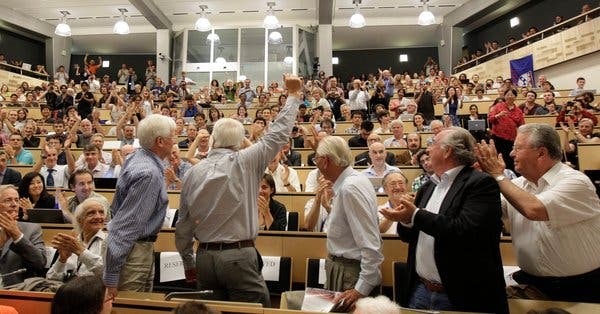
The surviving authors of the Higgs boson paper stand to a round of applause, after the discovery of the subatomic particle. (c) Denis Balibouse
This week, rumors surrounding the imminent discovery of the Higgs boson actually came through, after CERN scientists officially announced during a press conference that, indeed, they have finally come at the end of their long and arduous search for the elusive God particle. The whole event has been heralded as a historical milestone, as the Higgs boson was one of the unproven, key parts of the Standard Model of Physics, which describes the dynamics of subatomic particles and explains how the Universe is kept together.
“For me, it’s really an incredible thing that’s happened in my lifetime,” said Dr. Peter Higgs.
It was Higgs, along with five other physicists, working in three independent groups, who in 1964 described what came to be known as the Higgs field. In the paper, the scientists suggest that a new particle must be creating a “sticky” force field that acts as a drag on other particles and imbues elementary particles with mass. Without mass there couldn’t be any atoms, any life, any Universe. It’s no wonder, then, that the theory has been frustrating scientists for half a century.
The Higgs boson is a subject that’s been flying allover mainstream news all over the place lately; on the web, TV, car radio, virtually everywhere. It’s important then to understand, at a principle level at least, what a Higgs boson is. Everything is made up of atoms, and inside atoms are electrons, protons and neutron – this is science 101. The later, in turn, are made of subatomic particles like quark, fermion, lepton and boson. These can’t be subdivided and through their interaction within several unseen “fields”, allow the Universe to exist. Read our post which explains what a Higgs boson is and why it is important, for more details.
Indeed, however, the discovery, which was confirmed by two CERN teams, is an extraordinary event for science and humanity alike, and I can only rejoice at the amount of coverage and exposure it has gain in the press. During the conference, the five surviving authors of 1960s paper were also invited, Higgs included, and they were all treated to a welcome rivaled, maybe, only by rock stars.
The end of 50 year long hunt
One implication of theory described in Higgs’ original paper was that this cosmic molasses, normally invisible, would produce its own quantum particle if hit hard enough with the right amount of energy. The particle would be fragile and fall apart within a millionth of a second in numerous possible ways, depending upon its own mass. Unfortunately, decades ago there weren’t any particle accelerators powerful enough to find the boson, and even during the age of the $10 billion Large Hadron Collider facility in Geneva, finding the particle was a an incredibly difficult task since the theory didn’t describe the mass scientists were supposed to be looking after.
In the past two years alone, scientists have been crunching numbers from over 800 trillion proton-proton collisions! And it was well worth it; Dr. Higgs, himself, confessed that he was surprised that this discovery came so soon. The new particle has a mass of about 125.3 billion electron volts, as measured by the CMS group, and 126 billion according to Atlas. Both groups said that the likelihood that their signal was a result of a chance fluctuation was less than one chance in 3.5 million, “five sigma” – a rating standard in physics for a discovery, which makes it truly legitimate.
What’s next for physicists
So far, the physicists admit, they know little about their new boson, and physicists said that they would probably be studying the new particle for years. Actually, so far the only thing scientists can positively affirm at the moment regarding the Higgs boson is its existence. Many more questions remain unanswered, like its properties. Also, dwelling deeper inside the particle could begin to answer questions left hanging by the Standard Model, like what is the theorized dark matter which keeps cosmic entities, like galaxies, in balance.
“This could be the first in a ring of discoveries,” said Guido Tonelli of CERN.
“This is just the beginning,” says James Gillies, a spokesman for CERN.









